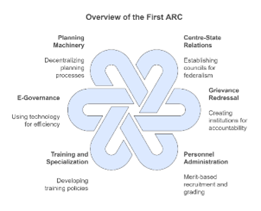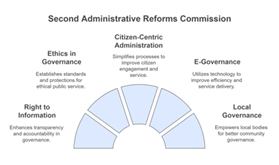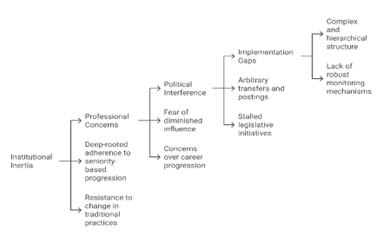THE CONTEXT: India’s governance challenges demand urgent reforms to modernize its bureaucracy, particularly the Indian Administrative Service (IAS), the backbone of the nation’s administrative machinery since independence. The country’s economic trajectory, marked by significant growth and innovation, is juxtaposed with persistent issues of income inequality, underinvestment in critical sectors, and bureaucratic inefficiency.
CHALLENGES THAT HINDER ITS EFFECTIVENESS AND EFFICIENCY:
-
- Politicization: Frequent transfers, suspensions, and promotions based on political loyalty rather than merit have undermined professionalism and morale within the service. Political interference often results in the best officers being sidelined, while politically aligned bureaucrats are rewarded with key postings. Officers often hesitate to take bold decisions for fear of political retribution, leading to policy paralysis.
- Lack of specialization: The generalist approach and frequent department rotations prevent officers from developing domain expertise, crucial for addressing complex governance issues. IAS officers are frequently rotated across departments, limiting their ability to develop domain expertise or gain in-depth knowledge of specific sectors.
- Corruption and inefficiency: According to the World Bank’s Government Effectiveness Index (2023), India ranks at 67.92 percentile globally. This moderate ranking reflects inefficiencies in public service delivery and policy implementation. According to the World Bank’s Government Effectiveness Index (2023), India ranks at 67.92 percentile globally. This moderate ranking reflects inefficiencies in public service delivery and policy implementation.
- Centralization of power: Under the current governance model, there has been an increasing centralization of power in the Prime Minister’s Office (PMO), which sidelines bureaucratic insights and reduces autonomy at senior levels. Senior IAS officers often find their roles reduced to executing decisions made at higher political levels rather than contributing to policy formulation. This disempowerment affects their ability to act as effective administrators.
REFORM EFFORTS AND INITIATIVES:


| Aspect | First ARC (1966-1970) | Second ARC (2005-2009) |
| Focus Areas | – Efficiency in administration
– Grievance redressal – Center-state relations |
– Ethics in governance
– E-governance – Citizen-centric governance |
| Notable Outcomes | -Proposal for Lokpal
– Inter-State Council – Merit-based recruitment |
– RTI Act implementation
– Citizen Charters – Performance-based promotions |
| Approach | – Structural reforms
– Unified grading structure – Decentralized planning |
– Process-oriented reforms
– Technology integration – Service delivery standards |
| Implementation Challenges | – Resistance from bureaucracy
– Limited political support – Institutional inertia |
– Lack of political will
– Bureaucratic resistance – Resource constraints |
-
- Lateral Entry Initiative: Lateral entry refers to recruiting professionals from outside the government into mid-level and senior positions, such as Joint Secretaries and Directors. This initiative aims to infuse domain-specific expertise into policymaking. Bridge the gap created by a shortage of IAS officers (approximately 1,500 vacancies). Bring fresh perspectives from sectors like technology, finance, and management.
- Accountability Measures: In T.S.R. Subramanian vs Union of India (2013), Supreme court directed states to establish Civil Services Boards to regulate transfers and postings, ensuring stability in tenures. It emphasized protecting bureaucrats from arbitrary political interference.
- Global Best Practices: The U.S. Department of Government Efficiency (DOGE), proposed under President Donald Trump, aims to streamline federal operations by eliminating redundant agencies. Reduce wasteful expenditures through data-driven decision-making. Enhance transparency by making government data publicly accessible.
Potential Lessons for India: India can adopt similar approaches to reduce red tape and simplify administrative procedures. Establishing public dashboards for real-time tracking of government spending can enhance accountability. Like DOGE’s temporary mandate tied to specific goals, India could set time-bound targets for implementing administrative reforms.
THE CHALLENGES TO REFORMS IN CIVIL SERVICES:

THE WAY FORWARD:
-
- Merit-based Recruitment and Promotions: Implementation of data-driven performance metrics for evaluation and promotion decisions. 360-degree evaluation system for comprehensive assessment of officers. Establishing transparent mechanisms for performance review and compulsory retirement of non-performing officers.
- Protection from Political Pressures: Establishment of Civil Services Boards with statutory powers as recommended by Supreme Court in TSR Subramanian case. Reiterate legislative initiatives like the Civil Services Standards, Performance, and Accountability Bill (2010).
- Encouraging Specialization: Providing opportunities for mid-career specialization through targeted training programs. Implementing domain expertise-based posting system for senior positions.
- Enhancing Data Infrastructure: Implementation of National Data Governance Framework Policy for standardized data management. Development of integrated platforms for performance tracking and evaluation. Creation of India Datasets program for evidence-based policymaking. Establishment of Data Management Units in every Ministry/Department.
THE CONCLUSION:
India’s administrative reforms require a three-pronged approach; immediate implementation of merit-based systems and protection mechanisms (as evidenced by the 67.92 percentile World Bank governance effectiveness ranking), medium-term focus on specialization and data infrastructure (supported by successful lateral entry of 57 domain experts by 2023), and long-term commitment to comprehensive reforms aligned with the vision of minimum government, maximum governance.
UPSC PAST YEAR QUESTIONS:
Q.1 The Doctrine of Democratic Governance makes it necessary that the public perception of the integrity and commitment of civil servants becomes absolutely positive. Discuss. 2024
Q.2 “Institutional quality is a crucial driver of economic performance”. In this context suggest reforms in Civil Service for strengthening democracy. 2020
MAINS PRACTICE QUESTION:
Q.1 “Lateral entry into civil services can bring expertise but poses challenges to administrative continuity.” Examine
SOURCE:
https://www.thehindu.com/opinion/lead/indias-steel-frame-does-need-a-check/article69020104.ece
Spread the Word
